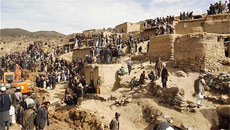Contrary to popular belief, the Tibetan Plateau, or the roof of the world, could be there even before the Himalayas, a study of fossils and oxygen isotopes of rocks in the southern parts of Tibet has said.
Conventional wisdom has it that the Tibetan Plateau rose as the Indian continent collided with Eurasia about 50 million years ago.
Parts of southern Tibet were already as mountainous as they are today even before the collision, the study noted.
The Tibetan Plateau, which has an average elevation of about 16,000 feet (4,900 metres), is ringed by the Himalayas to the south.
For the study, researchers analysed 55-million-year-old rocks from the Linzhou Basin, about 50 km northeast of Lhasa in Tibet.
They measured the isotopes of oxygen from ancient rain and snow that would have been preserved in the rock.
“As clouds climb up a mountain slope, water vapour with the heavier oxygen isotope, oxygen-18, rains out first,” said Ding Lin, a geologist at the Chinese Academy of Sciences’ Institute of Tibetan Plateau Research in Beijing.
The higher the elevation, the less oxygen-18 precipitates, whereas the opposite holds for oxygen-16. Thus, the ratio of the two isotopes is a measure of elevation.
The ratio the researchers calculated points to rocks with an elevation of around 4,500 metres, as high as they are standing today.
The findings also imply that the Asian monsoon could have been going on for much longer than previously assumed.
The findings appeared in the journal Earth and Planetary Science Letters.





